![]() and Jumper NEWS
and Jumper NEWS
By Andrei
Conovaloff -- NEWS added before 2004
Let me know what you like and don't like.
| Also see: Molokan People (Russian), Molokan Home Page, Molokan History, Molokan Genealogy 5 discussion groups: (Russian, Yahoo!, MolokanTown, MolokanCentral, MolokaniNarod, MolokanUnderGround); Doukhobors |
more Molokans adn Jumper NEWS: 2000, 2001, 2002, 2004
Back to Molokans and Jumpers Around the World
2003
"Molokan Exemption"= No
Photo on Driver's License Updated
14 Sept 2005-
2003 October 30 — In 1977 a California man, Benjamin Stackler,
requested no photo on his driver's license due to his religious belief.
He was denied. His research found the case of the Jumper-S&L-user
John Shubin who won a similar case in the 1960s. Stackler attended the
Molokan Church in San Francisco a few times, acquired a kosovorotka
(old style of Russian men's peasant shirt), consulted with Molokan
elders and Ethel Dunn, formed his own congregation (of one), appealed
his case in 1980 at which Ethel testified, and won in 1984 — Stackler
v. Department of Motor Vehicles (1980) 105 Cal.App.3d 240,
245. This June the DMV decided that the "Molokan [Jumper]
exception" was
too risky for national security and overturned it which was announced
in a press release on October 30. The Sacramento Bee covered
the story the next day. On November 18, Los Angeles
Jumper-S&L-users read the story in the Los Angeles Times
which created lots of gossip. And the following week on November 24 the
San Francisco Chronicle expanded the story with an interview
with Stackler. — Thanks to Nick Shubin for the tip. If
you know of any more accounts, please send them in.
Doukhobor Place Names
Database
![]() Nov 19
Nov 19
Jon Kalmakoff just added a new feature. Search this powerful, new
database containing over 400 Doukhobor Place names in Russia, Ukraine,
Georgia, Azerbaijan, Turkey, Canada and the US. Search by name, type,
alphabetically or geographically. The vast majority of the
Doukhobor place names occurred in Canada in the 20th century. There
were over 80 settlement in Saskatchewan and 100 in British Columbia
alone. Many were known by more than one place name, which accounts for
the surprising number of names. Also note that the Doukhobor Genealogy
website has moved to http://www.doukhobor.org .
The "Origins of Molokan adn Jumper Surnames" list moved to: www.doukhobor.org/Molokan.htm
Molokan-Jumper Holidays
![]() Sept 26
Sept 26
2003 Sept 26 — This evening begin the Jumper-S&L-user holidays in
America with the Memory of the Trumpet — Pamiat Trub. Would readers
please e-mail in the
holiday dates for the rest of this year and next year for the
Constants and Jumpers in America?
Russian Tour
of Doukhobors Planned ![]() Sept 25
Sept 25
2004 Summer — Koozma
Tarasoff is organizing a tour of the Doukhobor settlements in
Russia beginning with the Caucasus; through Rostov-on-Don; Chernski
raion, Tula province; and back to Moscow. The Tour is expected to be
some three weeks in duration. Molokan villages are nearby.
Armenia
Jumpers on Russian TV Show ![]() Sept 16
Sept 16
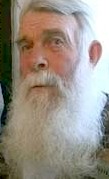 2003 September 7 — Russian TV show: Vokrug Sveta
(Around the World) — "Armenia Molokans" — Jumpers were interviewed on
the popular Russian TV show, with a magazine of the same title,
similiar to our National Geographic, but in 3 segments, like
60-minutes. The last segment is always about religion. Russians told us
that the first show this month interviewed Jumpers in Erevan and
Fioletova. We found the complete narration text on the show's website
with 5 new photos. The story will probably appear in the magazine.
Elder Novikov (shown) and wife, and the prophet Zadorkin and daughter
Iurtaiev were visited. Many facets of village Jumper life were
discussed — Saint Rudometkin, the language of Zion, beards, marriage,
diet, fasting, prohibitions, TVs, and preparation for the 200th
anniversary of religious freedom in 2005. See
a summary of the text. A complete translation will be posted later.
2003 September 7 — Russian TV show: Vokrug Sveta
(Around the World) — "Armenia Molokans" — Jumpers were interviewed on
the popular Russian TV show, with a magazine of the same title,
similiar to our National Geographic, but in 3 segments, like
60-minutes. The last segment is always about religion. Russians told us
that the first show this month interviewed Jumpers in Erevan and
Fioletova. We found the complete narration text on the show's website
with 5 new photos. The story will probably appear in the magazine.
Elder Novikov (shown) and wife, and the prophet Zadorkin and daughter
Iurtaiev were visited. Many facets of village Jumper life were
discussed — Saint Rudometkin, the language of Zion, beards, marriage,
diet, fasting, prohibitions, TVs, and preparation for the 200th
anniversary of religious freedom in 2005. See
a summary of the text. A complete translation will be posted later.
Vedda
Desatoff Recovering from 5-Year Coma
![]() Sept 11
Sept 11
2003 July 12 — North County Times — "A Story of Faith" by Brian
Hero, Staff Writer — "Her given name is Faith Desatoff, ...Vedda, which
means "faith" in Russian. The youngest of six children born to a
Russian family from Whittier, ... Cypress College to the state soccer
semifinals in ... Desatoff ...expected to start at center midfield. But
on Aug. 15, the very first day of practice, she went up for a header,
and the ball struck her on the upper left temple. ... She then lost
consciousness and slipped into a coma. ... Five years later,
she has never -- and will never -- come out of it. ... ... traumatic
brain injury (TBI), .....two priests from the family's traditional
Russian religion — Molokan [Jumper-S&L-user]
— were summoned to administer last rites.
...a rare operation known as a bilateral craniotomy, in which doctors
removed a pair of 2-by-4 inch pieces of her skull to relieve brain
swelling. ... "Now 24, Desatoff lives in CareMeridian, a residential
neuro-care facility in the Orange County city of Silverado. Clinically
comatose and physically disabled, she spends her days alternatively in
bed and in a wheelchair. She is fed three soft meals a day with a spoon
and one through a tube. Her mother, Priscilla, and father, Maury, visit
every weekend from Whittier, but her recognition of them is spotty and
she rarely smiles anymore."
Russia Train Explosion— 4
Killed, 92 Injured Updated Sept 16
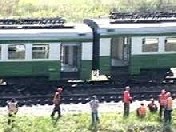 2003 September 3 — Kislovodsk, Stavropol'—
The morning commuter electric train (electrichka) which runs
between Kislovodsk and Mineral Waters, via Piatigorsk, was stopped when
a bomb on the tracks exploded about 7:30 am on Wednesday. On Thursday
September 4, 5 are reported dead and 79 injured. The bomb was placed in
an isolated area between the last Kislovodsk stop (platform) and
the first Essentuki stop. Many passengers were college students living
in the Kislovodsk area on their way to the university in Piatigorsk. Of
the 5 killed 3 were students. Many of the injured had severely damaged
legs and arms. Some were injured after the explosion in the rush to get
off the train. No word yet if any of the victim were Molokans. 7
Molokan churches are along this train route. Only one of the two tracks
on the route was damaged. Even though the explosion was 100 miles from
Chechnia, Chechens are the primary suspects. As reported earlier in
Molokan NEWS, many terrorist acts, mainly bombings, have occured in
Stavropol province where thousands of Molokans and Jumpers live. The
hospital
hostages in Budiennovsk, in 1995 the Piatigorsk train station 2nd floor
was blown out, again the Piatigorsk platform, the Essentuki main market
(rinok) was bombed, ... . My Russian-Molokan wife is from
Essentuki and we rode this train many times. By phone she learned that
a former co-worker was a passenger on the same train but in the next
car, was injured by shrapnel and died within a week leaving a small boy.
2003 September 3 — Kislovodsk, Stavropol'—
The morning commuter electric train (electrichka) which runs
between Kislovodsk and Mineral Waters, via Piatigorsk, was stopped when
a bomb on the tracks exploded about 7:30 am on Wednesday. On Thursday
September 4, 5 are reported dead and 79 injured. The bomb was placed in
an isolated area between the last Kislovodsk stop (platform) and
the first Essentuki stop. Many passengers were college students living
in the Kislovodsk area on their way to the university in Piatigorsk. Of
the 5 killed 3 were students. Many of the injured had severely damaged
legs and arms. Some were injured after the explosion in the rush to get
off the train. No word yet if any of the victim were Molokans. 7
Molokan churches are along this train route. Only one of the two tracks
on the route was damaged. Even though the explosion was 100 miles from
Chechnia, Chechens are the primary suspects. As reported earlier in
Molokan NEWS, many terrorist acts, mainly bombings, have occured in
Stavropol province where thousands of Molokans and Jumpers live. The
hospital
hostages in Budiennovsk, in 1995 the Piatigorsk train station 2nd floor
was blown out, again the Piatigorsk platform, the Essentuki main market
(rinok) was bombed, ... . My Russian-Molokan wife is from
Essentuki and we rode this train many times. By phone she learned that
a former co-worker was a passenger on the same train but in the next
car, was injured by shrapnel and died within a week leaving a small boy.
UMCA-LA
Picnic Saturday September 6 Updated Sept 4
2003 Sept 6 — Hacienda Heights — The LA-UMCA (United Molokan
Christian Association) resumes it's annual picnic at home. This year's
picnic will be held at the Hacienda
Heights location for the first time ever. The picnic was cancelled
last year for the first time since it was started in 1926.
Yasnaya
Polyana in Bulgaria Remembers Tolstoy ![]() Aug 22
Aug 22
 2003 August 21 — Ottawa, Canada — "Yasnaya
Polyana in Bulgaria Features
Conference on Lev N. Tolstoy" by Koozma J. Tarasoff — This Doukhobor
historian and author submits his article about "an interesting meeting
that was held last July in Yasnaya Polyana in Bulgaria." Koozma reports
that Yasnaya Polyana, Bulgaria, is revitalizing it's history with a
museum and an "...exhibition .... of 254 precious documents,
photographs, manuscripts about the connections of Tolstoy with his
Bulgarian followers and the new history of the village ..." For
Molokans: "Yasnaya Polyana" ("serene clearing") is the name of Lev
Tolstoy's estate in Tula province,
Russia, where he was born and buried. On farms in southern Tula
province live hundreds of resettled Molokan and Doukhobor refugees from
the Caucasus.
2003 August 21 — Ottawa, Canada — "Yasnaya
Polyana in Bulgaria Features
Conference on Lev N. Tolstoy" by Koozma J. Tarasoff — This Doukhobor
historian and author submits his article about "an interesting meeting
that was held last July in Yasnaya Polyana in Bulgaria." Koozma reports
that Yasnaya Polyana, Bulgaria, is revitalizing it's history with a
museum and an "...exhibition .... of 254 precious documents,
photographs, manuscripts about the connections of Tolstoy with his
Bulgarian followers and the new history of the village ..." For
Molokans: "Yasnaya Polyana" ("serene clearing") is the name of Lev
Tolstoy's estate in Tula province,
Russia, where he was born and buried. On farms in southern Tula
province live hundreds of resettled Molokan and Doukhobor refugees from
the Caucasus.
 Spirit Wrestlers Book Tour
Spirit Wrestlers Book Tour
![]() Aug
22
Aug
22
2003 — Ottawa, Canada — Doukhobor Writer Publishes Major Book in May
2003: Spirit Wrestlers: Doukhobor Pioneers Strategies for Living — by
Koozma J. Tarasoff — "Koozma J. Tarasoff took his new book on the road
for 7-weeks in May and June to do Readings, Signings, and Promotions in
Western Canada. Logging in some 13,000 [8078 miles] kilometers, ...[he]
... delivered books to customers ..., met them ... , autographed ... ,
and thanked his supporters for making it possible to help finance this
very expensive $100,000 book project with a CD-ROM. When the government
refused to provide any funding, Koozma went to the people for
pre-publication sales; the response showed trust in that 400 books were
purchased before [publication] ...."
 Russian Molokans and Doukhobors
Today
Russian Molokans and Doukhobors
Today ![]() Aug 20
Aug 20
2000 — Religion, State & Society — "Molokan And Doukhobors:
Living Source of Russian Protestantism" by Roman Lunkin and Anton
Prokof'yev — Translated from Russian — This article attempts to
summarize the status of Molokans and Doukhobors in Russia since perestroika.
The authors do a fair job of reviewing the history and analyzing the
politics of resurrecting these two sectarian groups after decades of
oppression, but they missed some major facts.
Armenia
Maksimists: 4 New Photos, Revised Story
![]() Aug 16
Aug 16
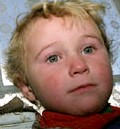 2003 January 17 — ArmeniaNow — "Bound
by Belief: Molokans hold
on to faith and tradition in changed world" by Viorica Vladica, ArmeniaNow
correspondent — 4 photos never before published and another first hand
story about Molokans and Jumpers in Armenia. The author is a journalism
student of
Mark Grigorian who sent this story in last year. Viorica wrote it in
English, but a few items were not clear, so we collaborated to clarify
the article and it was posted on Molokan NEWS February 5, 2003 as "FIOLETOVO" (Maksimist holiday Sedmina in Fioletovo).
She also rewrote it somewhat for publication in this Armenian magazine.
The value of promoting Molokans and Jumpers to the Armenians is to
prevent all
Molokans and Jumpers from leaving Armenia. At least 80% have moved to
Russia to
find work. Often children are left behind to be cared for by
grandparents who won't move. Armenian is now the official language.
Before the breakup of the Soviet Union only Russian was taught in all
schools. The Molokans' and Jumpers' Russian school in this village of Fioletova (formerly Nikitino) is
funded by private payments to the teachers who bus in daily from the
neighboring town of Lermontovo (Where Edgar Bibayoff of Big Church in
LA recently married an Armenian-Jumper bride.). There are some
public Russian language schools in Erevan. If American Jumpers
would fund just $100 per month, the village school could greatly
improve. Better if we would send volunteer teachers every 6 months in
rotation on tourist visas. But is seems that most American Jumpers do
not want to give or to associate with those "left behind", because many
believe that the grandparents of those in the FSU did not follow the
profesy to America to become "saved" like their grandparents did.
2003 January 17 — ArmeniaNow — "Bound
by Belief: Molokans hold
on to faith and tradition in changed world" by Viorica Vladica, ArmeniaNow
correspondent — 4 photos never before published and another first hand
story about Molokans and Jumpers in Armenia. The author is a journalism
student of
Mark Grigorian who sent this story in last year. Viorica wrote it in
English, but a few items were not clear, so we collaborated to clarify
the article and it was posted on Molokan NEWS February 5, 2003 as "FIOLETOVO" (Maksimist holiday Sedmina in Fioletovo).
She also rewrote it somewhat for publication in this Armenian magazine.
The value of promoting Molokans and Jumpers to the Armenians is to
prevent all
Molokans and Jumpers from leaving Armenia. At least 80% have moved to
Russia to
find work. Often children are left behind to be cared for by
grandparents who won't move. Armenian is now the official language.
Before the breakup of the Soviet Union only Russian was taught in all
schools. The Molokans' and Jumpers' Russian school in this village of Fioletova (formerly Nikitino) is
funded by private payments to the teachers who bus in daily from the
neighboring town of Lermontovo (Where Edgar Bibayoff of Big Church in
LA recently married an Armenian-Jumper bride.). There are some
public Russian language schools in Erevan. If American Jumpers
would fund just $100 per month, the village school could greatly
improve. Better if we would send volunteer teachers every 6 months in
rotation on tourist visas. But is seems that most American Jumpers do
not want to give or to associate with those "left behind", because many
believe that the grandparents of those in the FSU did not follow the
profesy to America to become "saved" like their grandparents did.
McDonald
Park Jumpers To Build New Church
![]() Aug 11
Aug 11
 2003 July 30 — Adelaide, South Australia — Messenger
— "Russian
church wins approval" by Verity Edwards — "Identity: Holding
true to tradition" — 2 articles with photos appeared after the city
council debated whether to allow the McDonald Park Jumper-S&L-user
congregation to build in a rural area outside Adelaide, SA. They have
35
family members and only 15 parking spaces at their Elizabeth South
industrial location. The local paper interviewed council members and
Presbyter Phillip Tolmachoff. "The council received four objections ...
But arguments in favour .. swayed ... the majority voting in favour."
"... we didn’t think it was going to be such an issue," Mr Tolmachoff
said.
2003 July 30 — Adelaide, South Australia — Messenger
— "Russian
church wins approval" by Verity Edwards — "Identity: Holding
true to tradition" — 2 articles with photos appeared after the city
council debated whether to allow the McDonald Park Jumper-S&L-user
congregation to build in a rural area outside Adelaide, SA. They have
35
family members and only 15 parking spaces at their Elizabeth South
industrial location. The local paper interviewed council members and
Presbyter Phillip Tolmachoff. "The council received four objections ...
But arguments in favour .. swayed ... the majority voting in favour."
"... we didn’t think it was going to be such an issue," Mr Tolmachoff
said.
Spirit & Life Diagrams
Explained by Scholars ![]() Aug 7
Aug 7
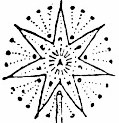 1992 —The American Journal of
Semiotics —"Semiotics of Inspired Illustration in a Molokan
[Jumper-S&L-user] Sacred
Text" — by Jules F. Levin and Steven E. Merritt,
University of California, Riverside — These 2 scholars studied
the Spirit and Life pictures published in 1915 and 1928 and how they
are arranged in the text. They explain that M.G. Rudometkin was
graphically interpreting the Bible, particularly the Book of
Revelations, to better understand it for for himself and his followers.
"Unlike conventional illustrations which may present information
otherwise not conveyed in the text, these drawings diagram the text
itself, in some cases (as in Fig. 6) condensing a great deal of textual
information into an image that may be contemplated."
1992 —The American Journal of
Semiotics —"Semiotics of Inspired Illustration in a Molokan
[Jumper-S&L-user] Sacred
Text" — by Jules F. Levin and Steven E. Merritt,
University of California, Riverside — These 2 scholars studied
the Spirit and Life pictures published in 1915 and 1928 and how they
are arranged in the text. They explain that M.G. Rudometkin was
graphically interpreting the Bible, particularly the Book of
Revelations, to better understand it for for himself and his followers.
"Unlike conventional illustrations which may present information
otherwise not conveyed in the text, these drawings diagram the text
itself, in some cases (as in Fig. 6) condensing a great deal of textual
information into an image that may be contemplated."
1938 San Francisco Faces Identified ![]() Aug 5
Aug 5
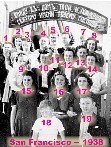 Have you wondered who the people are that were
photographed in 1938 and appear on the Library of
Congress website? "On Sunday, September 14, 1938 .. Folklorist
Sidney Robertson Cowell recorded the distinctive preaching and
singing..." and took some pictures. About 1997, the Library of Congress
put this collection on their website. You can hear our Molokans in 1938
singing, speaking, and see them. This year, genealogist Nancy
Poppin-Posey asked her relatives in San Francisco who the faces were.
They found Agapoffs, Esaieff, Fetesoff, Klistoffs, Loskutoffs, Poppins,
Semenoffs, Sohriakoff, and several unidentified which you might know.
"Thanks to my cousin Ann Pappin Loskutoff and the Potrero Hill ladies
who identified names to the faces and identified their spouses. — Nancy Poppin-Posey"
Have you wondered who the people are that were
photographed in 1938 and appear on the Library of
Congress website? "On Sunday, September 14, 1938 .. Folklorist
Sidney Robertson Cowell recorded the distinctive preaching and
singing..." and took some pictures. About 1997, the Library of Congress
put this collection on their website. You can hear our Molokans in 1938
singing, speaking, and see them. This year, genealogist Nancy
Poppin-Posey asked her relatives in San Francisco who the faces were.
They found Agapoffs, Esaieff, Fetesoff, Klistoffs, Loskutoffs, Poppins,
Semenoffs, Sohriakoff, and several unidentified which you might know.
"Thanks to my cousin Ann Pappin Loskutoff and the Potrero Hill ladies
who identified names to the faces and identified their spouses. — Nancy Poppin-Posey"
Tolmachoff's Produce Stand,
Glendale, Arizona ![]() July 5
July 5
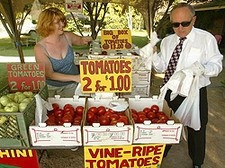 2003 July 5 — The Arizona Republic,
by Rhea Davis — "What a sweet deal!: Produce stands are open in West
Valley" — "Tomatoes are bright red and a great green at Tolmachoff's
Garden Fresh Produce Stand on 75th Avenue Diane [Bolderoff from Kerman]
and Ephrem also sell cucumbers, zucchini, sweet corn, honeydew,
cantaloupes and watermelon. ... Ephrem Tolmachoff's Garden Fresh
Produce Stand is on 75th Avenue, a half-mile south of Glendale Avenue.
... The stand, which has been operating in Glendale for 10 years, sells
produce grown on Tolmachoff's farm [rented]. Tolmachoff, 45, a Glendale
resident, has been growing
vegetables since he was a child. He said he experimented with different
kinds of tomatoes until he found the ones he now sells. He described
his tomatoes as being like beefsteak tomatoes, but juicier and tastier.
All the produce he sells is picked the same day, he said, ... Just
about everyone who stopped at the stand last week left with a bag of
tomatoes. ... Tolmachoff keeps his stand open during harvesting season,
from mid-May until the third week of July."
2003 July 5 — The Arizona Republic,
by Rhea Davis — "What a sweet deal!: Produce stands are open in West
Valley" — "Tomatoes are bright red and a great green at Tolmachoff's
Garden Fresh Produce Stand on 75th Avenue Diane [Bolderoff from Kerman]
and Ephrem also sell cucumbers, zucchini, sweet corn, honeydew,
cantaloupes and watermelon. ... Ephrem Tolmachoff's Garden Fresh
Produce Stand is on 75th Avenue, a half-mile south of Glendale Avenue.
... The stand, which has been operating in Glendale for 10 years, sells
produce grown on Tolmachoff's farm [rented]. Tolmachoff, 45, a Glendale
resident, has been growing
vegetables since he was a child. He said he experimented with different
kinds of tomatoes until he found the ones he now sells. He described
his tomatoes as being like beefsteak tomatoes, but juicier and tastier.
All the produce he sells is picked the same day, he said, ... Just
about everyone who stopped at the stand last week left with a bag of
tomatoes. ... Tolmachoff keeps his stand open during harvesting season,
from mid-May until the third week of July."
3-day Harvest
Fast & Prayers for Unity
![]() July 5
July 5
2003 May 22 thru Saturday May 23, 2003 — Break Fast on Sunday May 24,
2003 — In South Russia there is a drought, Molokans there need rain to
grow their gardens. A 3-day fast with prayer is called among all
believers for (1) rain, (2) to unite all Molokane, and (3) to unite the
world in peace and love for all faiths. Too much rain came last summer
and destroyed the crops and harvest. This year appears to be the
opposite. Pass this message on to your congregation, collect charity
and send it to Molokans in need in Russia. UPDATE: Rain fell 2 weeks
later, on June 5. Thanks to everyone's prayers.
Arizona Treguboff Recollects History
![]() May 2
May 2
2003 May 2 — Sun Cities-Surprise Section, The Arizona Republic:
"Plenty of work for boy on early Glendale farm" — by Gerry Niskern —
"Fred Treguboff, 64, grew up in Glendale. His mother died when he was
5, and he went to live with his Russian grandparents on their farm on
Lateral 20 (75th Avenue) and West Glendale Avenue."
International
Molokan Convention May 1-3 ![]() Apr 12
Apr 12
All Molokans around the world are invited to the 2003 annual
convention of Molokans, May 1-3 (Thur-Fri-Sat) this year, hosted by the
Kochubeevskoe congregation in Stavropol'. The purpose of this meeting
is to plan for the 200th aniversary of religous freedom for Molokans to
be held in July 2005. So far 20 congregations have appointed 53
delegates and more help is needed. This Molokan NEWS website is hosting
announcements posted on the Internet.
Potrero
Hill Neighborhood House
 "This neighborhood
house was established in 1919 by the Presbyterian Church to serve the
Russian immigrants who had been settling on the hill since 1905. ...
some two thousand Russian immigrants, mainly from the Volga and
Caucasus regions, arrived after fleeing Czarist oppression. Known as
the "Molokani," the milk drinkers, they were a puritanical sect who
worshiped at a modest little church where the women and men were
segregated during services. At the Potrero Hill Neighborhood House, ...
the Russians took classes in the English language and learned how to
use sewing machines...."
"This neighborhood
house was established in 1919 by the Presbyterian Church to serve the
Russian immigrants who had been settling on the hill since 1905. ...
some two thousand Russian immigrants, mainly from the Volga and
Caucasus regions, arrived after fleeing Czarist oppression. Known as
the "Molokani," the milk drinkers, they were a puritanical sect who
worshiped at a modest little church where the women and men were
segregated during services. At the Potrero Hill Neighborhood House, ...
the Russians took classes in the English language and learned how to
use sewing machines...."
Molokan history in
Utah ![]() Apr 10
Apr 10
2003 April 10 — "Russian Colonists in the Utah Desert" — by Dr.
Marshal Bowen. A research paper about Molokans and Jumpers in Utah
was
presented today at the WSSA—Western Social
Science Association—annual conference in Las Vegas, Nevada (April 9-11),
in the panels on Arid Lands. (See page 16 of the
PDF schedule). Dr. Marshal Bowen will explain what he knows
about the migration of Molokans adn Jumpers to Utah in Panel Session
IV: Desert
Identities, Thursday at 2:45 pm. This is a continuation of his work on
how "city
people went to poor lands at this time". After the conference,
Bowen will spend a week in Arizona. The Arizona Jumper-S&L-user
congregation
will meet with Bowen to share information about the Arizona Molokan
settlements and learn more about his work. See
earlier posts. Dr. Bowen will share his paper and color photos with
us which should be posted here probably next week. —- Also check
the Slavic Studies
panels on page 82. The paper on page 85, presented in Panel 11 :
“Arbiters
of the Free Conscience: State, Religion, and the Problem of
Confessional Transfer after 1905,” Paul W. Werth, University of
Nevada, Las Vegas, mentions Molokans and Doukhobors. I have this in PDF
from Werth. If you want a copy let me know.
2003 Jumper Holidays
![]() Apr
10
Apr
10
Paskha (Passover) starts Monday evening April 14 with
"Breaking of the Bread". American Jumper-S&L-users often refer to
this day in
Russian as Paskha zaedat' translated as "to take (passover)
bread with" — an old peasant way of referring to communion. In Russia
the bread is taken with salt. The holiday proceeds for 7 more days,
ending Monday April 21. Note that in Orthodox Russia, paskha is
a cheese spread that is put on kulich (sweet bread). For some
reason Molokans and Jumpers, particularly in America, labeled the
sweet-bread paskha. See
more about paskha and kulich. I don't have the
complete holiday calendar to post yet. If someone can e-mail it in, all
the readers will appreciate you help.
The
Molokans: A little-known sect on Potrero Hill
![]() Apr
1
Apr
1
1975 — By George John Poppin — "Dad had this article in his things.
There wasn't a date, and surmised it was before 1975 because my cousin,
Vasily Petrovich Semenoff, mentioned in the article, died October 22,
1974 in San Francisco. It may be of interest for the Molokan News." — Submitted by Nancy Poppin-Posey
The
Lord’s Mercy: The Holy Spirit in Action ![]() Apr 1
Apr 1
A spiritual lesson by Nick Ghosoph, Fresno CA, who vows: "I promised
Him that I would speak about his mercy until I depart!" These 4
parts were written by Nick, submitted to "The Molokan" (the UMCA
newsletter) and distributed among American Jumper/Maksmists over a
period of several months. They are submitted here as a collected
first-hand report of how the Holy Spirit works among the Spiritual
Christians. Thanks to Nick & Joseph for submitting
it.
"The
Russians Are Coming!" ![]() Mar 26
Mar 26
1982 Spring — Elite Society Magazine — "The Russians
Are Coming! The Russians Are Coming!" — by Bill Coates — Using the same
title of a popular comedy movie about the same time, Coates interviews
the larger Conovaloff family of Arizona—and particularly the oldest
Jumper, Martha Papin. After her husband Nick died, Martha married the
widowed presbyter, Vasili Tolmachoff, until he died. Martha
lived to a few days shy of 100. Thanks to the
Papin-Poppin family — Nancy, Debbie, and Fae for sending in the source
files.
500 active Molokans in
Azerbaijan? ![]() Mar 14
Mar 14
The State Committee of Azerbaijan Republic of the work with
religious associations — This report: Who are Molocans?
provides a short history and demography: "Molocans are one of the sects
of spiritual Christianity. The founder ... was peasant of Tambov Semen
Uklein. He was Orthodox, but then he joined sect of spiritual fighters [Doukhobors], then he separated and established
his own circle. He chose 70 'apostles' among his followers and
triumphantly entered Tambov singing religious songs so that to teach
his new doctrine openly. But police arrested them and put into prison.
... Molocans don't have churches, and dogmatic doctrine of Molocans is
stated in so called Books of Rites... At the present time
there are 11 registered communities of Spiritual Christian
Molocans in Azerbaijan. The largest of them are located in Baku
(about 150 persons) and in Sumgait (about 100 persons). Other
communities consisting of no more than 10 persons act in Shemakhi,
Garadag, Hizi and Ismailli areas. There are
also some unregistered communities in those areas. In all communities
is conducted calculation of members, who are elderly people. The young
people and children usually don't attend communities. The members are
only citizens of Russian nationality. The communities don't act as
missionaries and the number of their members reduces year by year. ...
They don't have religious centre and each community acts independently.
At the same time they support close relations with Baku community and
Molocan communities of Stavropol. The financial income is not high and
is used to support financial help to their members and worship houses.
Last years the tendency of closing of many communities because of the
lack of the people is observed. General number of all members of
Molocan communities is about 500 persons." [This
500 number appears to count only those who attend sobrania.
Click here to see the
Russian version.]
Slovo
Very (Word of Faith) published again ![]() Updated
Mar 14
Updated
Mar 14
2003 — The Russian Molokan religious journal Slovo Very
(Word of Faith) was last published in Moscow from 1994 to 1996. Click to see the
online editions for 1994 to 1996. This year the Molokan Center in
Stavropol' published the first edition in 8 years. Co-editor Sergei
Ryzhkov e-mailed it to us in 2 parts. Click here to see
Ryzhkov's letter. Click
here to see a translation of the Table of Contents, and at
the bottom you can download your own 60 page copy in brilliant PDF
format—a 380KB size file. It's best just to save the file on your PC to
read anytime you want.
San Francisco Molokans in Student Report
![]() Feb
28
Feb
28
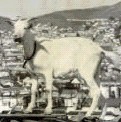 2002 June 5 — (28 page PDF file) — "Poppy
Hill, Goat Hill, Holy Hill...Potrero Hill: The Cultural and Development
of San Francisco's Sunniest Neighborhood" by Lisa Schiller —
According to an original Molokan settler, Vasily S. Fitisoff, there
were 30 Molokans in the original group arriving days after the Great
San Francisco Earthquake and Fire of 1906. [Most came from the failed
commune in Hawaii.] "The City authorities did not know what to do with
them so they sent them to the city dump on Potrero Hill in garbage
wagons. They were thrown together with earthquake and fire victims and
lived in emergency tents and refugee shacks until the community was
further settled. After the cleanup of the earthquake the government
began building prefabricated houses on Potrero Hill, but they were in
short supply so the Molokans began building their own. Although small,
the new homes were considered more than adequate, compared to their
previous living conditions in Russia. Once this initial settlement
occurred more Russians, including Russian Baptists, joined the Potrero
Molokan community." In 1906 they divided themselves into 2 separate
religious communities — Constants and Jumpers — and began working for
Union Iron Works. One of the centerpieces of the Molokan Community was
the Molokan Church, built on Carolina Street in 1937, which has been
replaced. Jumper Molokans closed their "sobraniia" and joined the new
Constant church in the 1960s when most on Potrero Hill walked to
church. The neighborhood, also called "Goat Hill" for a large goat
farm, and "Holy Hill" for many religous groups, is sunny, isolated from
fog and traffic and has the best view of Downtown. Locals called the
western side “Russian Hill” or “Little Russia” and described the first
Russian settlers as “very big guys with beards. They were loud talking
and hard drinking.” "In the 1970s the Russian Molokans were known to be
a very insular and quiet group that preferred not to attract attention
to themselves. Their community had grown over the years, even up to 700
in 1945, but greater numbers created further diffusion of their
religious communities."
2002 June 5 — (28 page PDF file) — "Poppy
Hill, Goat Hill, Holy Hill...Potrero Hill: The Cultural and Development
of San Francisco's Sunniest Neighborhood" by Lisa Schiller —
According to an original Molokan settler, Vasily S. Fitisoff, there
were 30 Molokans in the original group arriving days after the Great
San Francisco Earthquake and Fire of 1906. [Most came from the failed
commune in Hawaii.] "The City authorities did not know what to do with
them so they sent them to the city dump on Potrero Hill in garbage
wagons. They were thrown together with earthquake and fire victims and
lived in emergency tents and refugee shacks until the community was
further settled. After the cleanup of the earthquake the government
began building prefabricated houses on Potrero Hill, but they were in
short supply so the Molokans began building their own. Although small,
the new homes were considered more than adequate, compared to their
previous living conditions in Russia. Once this initial settlement
occurred more Russians, including Russian Baptists, joined the Potrero
Molokan community." In 1906 they divided themselves into 2 separate
religious communities — Constants and Jumpers — and began working for
Union Iron Works. One of the centerpieces of the Molokan Community was
the Molokan Church, built on Carolina Street in 1937, which has been
replaced. Jumper Molokans closed their "sobraniia" and joined the new
Constant church in the 1960s when most on Potrero Hill walked to
church. The neighborhood, also called "Goat Hill" for a large goat
farm, and "Holy Hill" for many religous groups, is sunny, isolated from
fog and traffic and has the best view of Downtown. Locals called the
western side “Russian Hill” or “Little Russia” and described the first
Russian settlers as “very big guys with beards. They were loud talking
and hard drinking.” "In the 1970s the Russian Molokans were known to be
a very insular and quiet group that preferred not to attract attention
to themselves. Their community had grown over the years, even up to 700
in 1945, but greater numbers created further diffusion of their
religious communities."
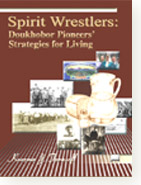 Spirit
Wrestlers due in April
Spirit
Wrestlers due in April
![]() Feb 28
Feb 28
2003 Feb 27 — Koozma Tarasoff's reports that his next big book: Spirit Wrestlers: Doukhobor
Pioneers' Strategies for Living will go to press at the end of
March, then he says: "Once the book is out, I plan in April to head out
with a carload of books to Western Canada and hold some Readings, Book
Signing, and showing of images ... demonstrate the use of the
interactive CD-ROM... I plan to deliver books directly to the customers
who are in my route. I expect it will take me some five weeks of
exciting sobranies, visits, ... I expect some debates along the way
esp. on the issue of zealotry, orthodoxy, and criteria of who is a
'pioneer'." The book will also be on CD. See
excerpts and order it at: http://www.spirit-wrestlers.com
Note this is Koozma's 25th book about Doukhobors, in addition
to 61 articles, and 44 other projects!
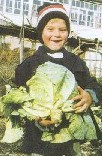 Jumper-S&L-user
holiday Sedmina in Fioletovo
Jumper-S&L-user
holiday Sedmina in Fioletovo
![]() Feb
5
Feb
5
2002 Dec — Fioletovo by Viorica Vladica — Victor and
Sasha Zadorkin invite you to their Jumper holiday service
"Sedmina" as reported by a Moldovan journalism student in her early
20's who came to Armenia to study journalism at the Caucasus Media
Institute, where Mark
Grigorian is the deputy director. Viorica researched and wrote this
article herself in English.
Fading Fortunes of
Molokans in Armenia ![]() Feb 5
Feb 5
2001 Nov — Armenia: Fading Fortunes of 'Little Russia' — By
Mark Grigorian in Fioletovo — Interviews Tatiana Mechikov. Here's
another first-hand report from one of Armenia's lead journalists and
media analysts about the condition of Molokans and Jumpers in the new
Armenia.
Canadian
Agency Helps Molokan Refugees ![]() Feb 5
Feb 5
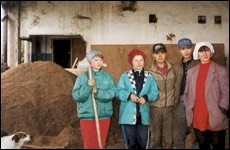 1993 — "Going with the grain in
Russia" — 19 Molokan families fleeing war in Azerbaijan arrived in the
Tulskaya region, three hours' drive from Moscow. They got a small,
deserted village with one building and no roads leading to the village.
$16,500 from CIDA—Canadian International Development Agency—brought
them a grain separator, grain cleaner, and mill to help them survive.
1993 — "Going with the grain in
Russia" — 19 Molokan families fleeing war in Azerbaijan arrived in the
Tulskaya region, three hours' drive from Moscow. They got a small,
deserted village with one building and no roads leading to the village.
$16,500 from CIDA—Canadian International Development Agency—brought
them a grain separator, grain cleaner, and mill to help them survive.
Kheryn
Klubnikin on world peace & ecology Updated Feb 13
2002 Fall — The role of the environment, especially forests, in
peace, conflict, and human security (Klubnikin & Causey, 2002)
— Kheryn Klubnikin graduated from USC and did her graduate work at
California State University Fullerton. She reports: "I continue to have
a keen interest in all aspects of Russian history, especially the lives
of people in Anatolia who fled from the Ottoman Turks. ... In April
I'll be singing some classical Russian songs for a friend's art opening
in Georgetown [Washington DC]." She is the environment chair for the
Washington DC Chapter of the Society for International Development,
conducting inquiry into the interface between western science and
traditional ecological knowledge, particularly in the Russian
Altai and Central Asia, where she visited about 5 times. She is an
ecologist with USDA (Dept. of Agriculture) Forest Service Research in
Washington, DC, and participated in the first exchange on biodiversity
between the US National Academy of Sciences and the Russian Academy of
Sciences in 1992-1993. This paper she co-authored correlates world
peace to protection of the eco-system.
Doukhobors Still Working for Peace
![]() Jan
23
Jan
23
2002 Jan 22 — "Protest in Ottawa Brings Consensus Against War in Iraq"
by Koozma Tarasoff — This Doukhobor historian reports first hand about
his work for world peace. "Activists invoked the non-violent legacy of
Martin Luther King Jr.
on the U.S. holiday weekend that marks the civil rights leader's
birthday." Canadian Doukhobors feel it is their historic duty to
evangelize for peace, but American Molokans and Jumpers have lost this
part of their heritage.
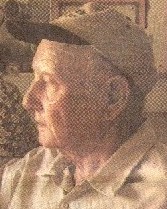 Mexico
Molokans Still There
Mexico
Molokans Still There ![]() Jan 23
Jan 23
2002 Dec 1 — Los Angeles Times — By Jessica Garrison —
A reported 300 people of Molokan and Jumper descent still live near the
Fransico
Zarco, formerly the Russian Colony of Guadalupe, about 50 miles south
of the boarder. Fewer than 20 are "pure" Russian. The church ha been
closed for decades. This story features Gabriel Kachirisky (right) who
repaired the neglected church (big hole in the roof) cleans the
cemetery and makes a little catering to the tourist trade. The village
now has 2 Molokan museums, tour buses stop for Russian lunch and a
history lesson.
New Church in Samara,
Russia ![]() Jan 23
Jan 23
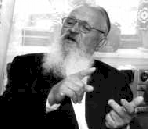 2001 Aug 29
— Tol'iatti, Samara, Russia — Tol'iattinskoe Obozprenie (Tol'iatti
Review) — This city is about 40 miles (60 km.) northeast of Samara,
location of the "Molokan-Mormons":
2001 Aug 29
— Tol'iatti, Samara, Russia — Tol'iattinskoe Obozprenie (Tol'iatti
Review) — This city is about 40 miles (60 km.) northeast of Samara,
location of the "Molokan-Mormons":
"Molokans found their prayer house
"Last Sunday a blessing and opening of a
prayer house took place for the Spiritual Christian Molokans. The
believers waited almost 4 years for this event.
"In 1998 the city [of Tol'iatti] authorities
allotted the congregation (obshchina) land to build a prayer
house and 10,000 rubles. The congregation members added more money and
rapidly started to build.
"And finally a spacious 2-story house for
prayer was built. For a special blessing from Stavropol' region, where
the the Molokan spiritual center is situated, came the elder presbyter
of the Russian Union of Spiritual Christian Molokans Timofey Schitinkin
[in photo]. For parishioners gather about 80 people. By tradition, they
read the Bible and sing Psalms.
"The trustee of the Tol'iatti congregation
Vasili Lankin said that the prayer house is open for everybody and
religious readings will be held every Sunday."
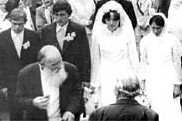 Armenian-Molokan
Photogallery
Armenian-Molokan
Photogallery ![]() Jan 22
Jan 22
The Cultural Diversity in Armenia website added 5 photos of
Armenian Molokans and Jumpers. This wedding scene is part of one. 2 old
photos and
3 recent shots are featured. This page links to Ivan
Semionov's report on the history of Molokans in Armenia.
100s
of Molokan Genealogy Postings ![]() Jan 14
Jan 14
2003 January 14 — Find 318 postings on the Molokan
and Jumper Genealogy Board since it was founded
February 2002, and 181
questions posted on all board regarding Molokans since June 2000. Thanks
to Ancestry.com for sponsoring
the service.
more Molokan and Jumper NEWS: 2000,
2001, 2002,
2004
Back to Molokans and Jumpers Around the World